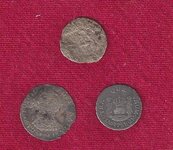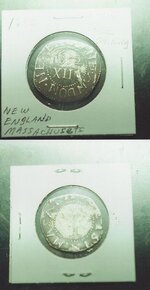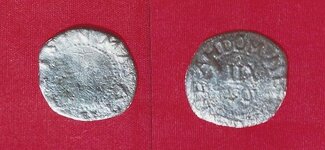Castineman1779
Sr. Member
Well I think for most coin shooters the "Holy Grail" of coins are indeed 1652 Massachusetts Willow, Oak and Pine tree coins minted in that state. I know the excitement is hard to describe and I think Abe (Ahab8) shared that with us recently with his find of a wonderful Pine Tree shilling. He has been only at THing since September of last year and already the Pine and a silver cobb coin has come under his coil. I am always excited to read others finds and one thing we share is the passion for this hobby.
Now let me get to what I am posting here and what I found at my site in Castine, Maine earlier this year. If you have read my other 3 posts you know I have been a relic hunter in Castine for 14 years and those posts were about relics and coins found there. Besides Revolutionary War relics I was fortunate to find my first Mass coin on a rocky beach on the mainland and I will put up a few pics after this post to show you.
Earlier this year I was working that same beach and further up from the Oak tree shilling find in 2001 was a ferry that was in use from the mid 1850s to turn of the century. As you know ferry crossing can be very productive if worked slowly and listen for deep targets. They are obvious sites for coin hunters and heavily hunted. My first finds were brass ships nails and then came up a 1761 Spanish one real that over the years in salt water and mud was quite thin but the old Spanish king's image and date still clear. I love Spanish silver and understand like the Mass silver coins in circulated thru the 1850s. I was happy with this one silver and in my film canister it went. Next some more brass nails . Another 20 minutes only noise on my DFX was a steady hum of the threshold . Folks had in the past hunted this beach well. Then I get a light deep tone in the silver range on the meter and up comes another little silver coin I thought might be the smaller 1/2 real due to it's size. So in the film canister it goes. Not bad to end up with two Spanish silver. However like in the commercials were they say "Wait there is more" indeed there was and when I returned to my cabin for the night and to look at the Rev War relics I found on Castine peninsula earlier that day and the brass nails and Spanish coins on the mainland I took notice that the second silver coin did not meet the standard of a 1/2 real in that it was not completely round plus probably best way to describe it chunkier than the thin half real of which I have found one other dated 1758. In fact like the early Mass tree coins it had one side thick and one side thin that was similar to the Oak tree shilling I had found on that same beach in 2001.
Now in further study of the coin any imprint or image on it is long gone from being in salt water and mud. It cannot be ided to a Mass coin so I used the size of known examples of the Pine and Willow tree threepence varieties in Yoeman's Redbook for comparison. Also compared it to the Pine tree in the array of coins called The Castine Hoard. In my opinion since the Willow tree threepence are so rare with only 3 examples know I feel this coin is the more common Pine tree. However it is an individual loss like my 1652 Oak tree not from a hoard. That is my opinion and I welcome yours. Now I will say if you have knowledge of the Mass coins please chime in with an opinion . Here are some pics for comparison. Note the last one on the right is from the Castine Hoard and blown up. The coins are the same size. May not be any value in this condition but still it I believe is a Mass coin . Hope you enjoyed my story and happy hunting. Gary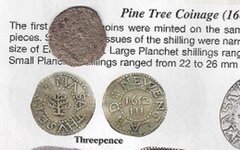
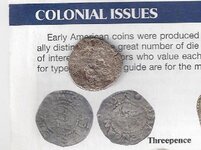
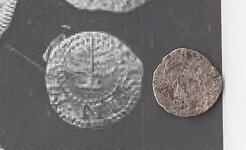
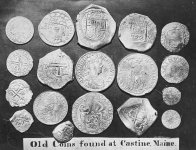
Now let me get to what I am posting here and what I found at my site in Castine, Maine earlier this year. If you have read my other 3 posts you know I have been a relic hunter in Castine for 14 years and those posts were about relics and coins found there. Besides Revolutionary War relics I was fortunate to find my first Mass coin on a rocky beach on the mainland and I will put up a few pics after this post to show you.
Earlier this year I was working that same beach and further up from the Oak tree shilling find in 2001 was a ferry that was in use from the mid 1850s to turn of the century. As you know ferry crossing can be very productive if worked slowly and listen for deep targets. They are obvious sites for coin hunters and heavily hunted. My first finds were brass ships nails and then came up a 1761 Spanish one real that over the years in salt water and mud was quite thin but the old Spanish king's image and date still clear. I love Spanish silver and understand like the Mass silver coins in circulated thru the 1850s. I was happy with this one silver and in my film canister it went. Next some more brass nails . Another 20 minutes only noise on my DFX was a steady hum of the threshold . Folks had in the past hunted this beach well. Then I get a light deep tone in the silver range on the meter and up comes another little silver coin I thought might be the smaller 1/2 real due to it's size. So in the film canister it goes. Not bad to end up with two Spanish silver. However like in the commercials were they say "Wait there is more" indeed there was and when I returned to my cabin for the night and to look at the Rev War relics I found on Castine peninsula earlier that day and the brass nails and Spanish coins on the mainland I took notice that the second silver coin did not meet the standard of a 1/2 real in that it was not completely round plus probably best way to describe it chunkier than the thin half real of which I have found one other dated 1758. In fact like the early Mass tree coins it had one side thick and one side thin that was similar to the Oak tree shilling I had found on that same beach in 2001.
Now in further study of the coin any imprint or image on it is long gone from being in salt water and mud. It cannot be ided to a Mass coin so I used the size of known examples of the Pine and Willow tree threepence varieties in Yoeman's Redbook for comparison. Also compared it to the Pine tree in the array of coins called The Castine Hoard. In my opinion since the Willow tree threepence are so rare with only 3 examples know I feel this coin is the more common Pine tree. However it is an individual loss like my 1652 Oak tree not from a hoard. That is my opinion and I welcome yours. Now I will say if you have knowledge of the Mass coins please chime in with an opinion . Here are some pics for comparison. Note the last one on the right is from the Castine Hoard and blown up. The coins are the same size. May not be any value in this condition but still it I believe is a Mass coin . Hope you enjoyed my story and happy hunting. Gary




Last edited:
Upvote
1


